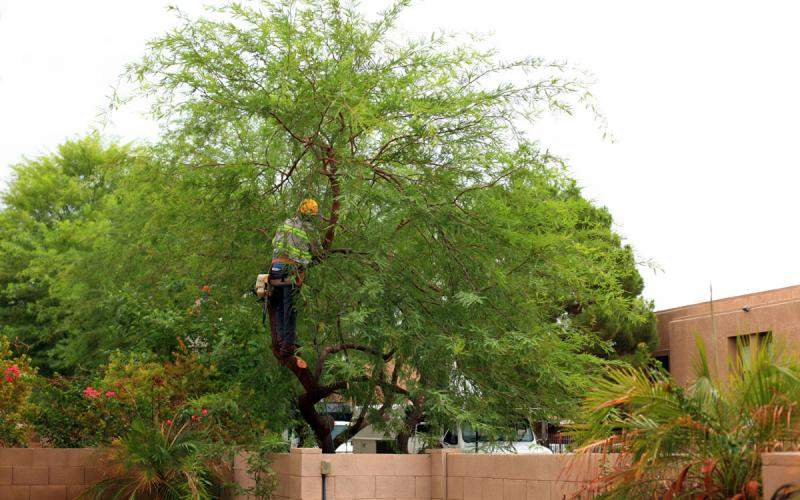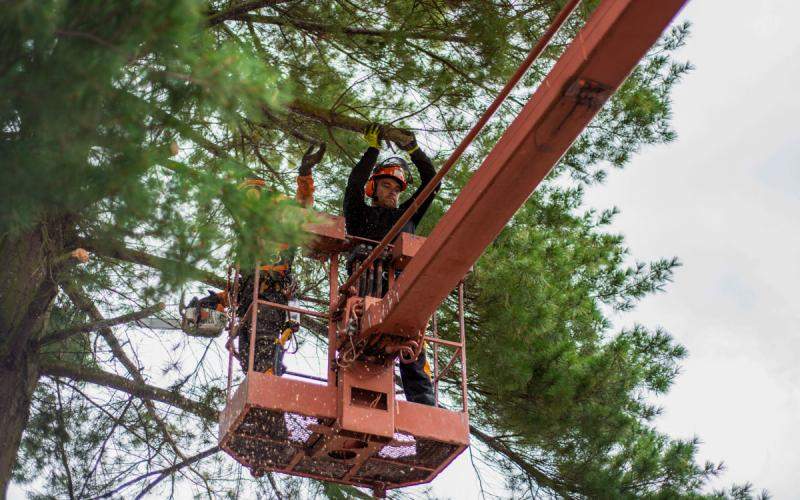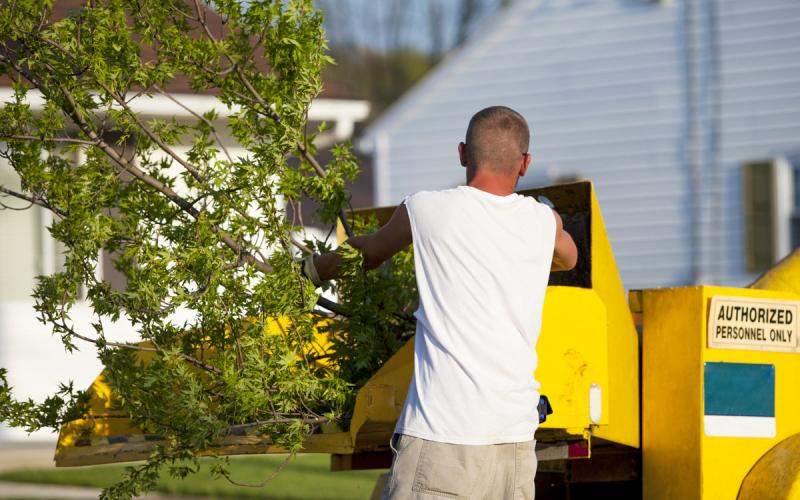What Does a Tree Service Company Provide?
Tree work can be destructive, risky, and even fatal, if performed improperly, or by poorly trained personnel. Here are the most common services that you can expect from a tree service company.
By: Sylvia Slezak | Mar 2020
 Swing installed on tree
photo by csp_Magryt
Swing installed on tree
photo by csp_Magryt
Trees contribute to the air we breathe, provide shade on sunny days, produce flowers, yield fruits and nuts, and supply strong barks to build houses, design furniture, make paper, and other goods. But, maintaining healthy trees takes knowledge, training, and experience. Employees, passersby, and unsuspecting pedestrians or drivers can be injured by sloppy, inexperienced crews.
Tree work is not a game nor is it for the careless, unskilled, poorly trained. Removing or pruning can seldom be done over, unlike a paint job or other home improvement. Guesswork, crossed fingers and hope are not part of the program when working with chainsaws on the ground or high in a tree, not to mention rigging limbs or blocks of wood that can weigh well over one thousand pounds. Second chances are rare.
Many companies everywhere claiming to be tree care experts make it difficult for homeowners to choose the right company. In some places there are hundreds of tree service businesses to sort through. How is a homeowner to know who to select, especially when they use creative marketing tactics and sale gimmicks? Not to mention that some even recommend unnecessary services.
Choose wisely. Make sure to hire an insured, experienced, credentialed company by verifying their licensing, certifications, and insurance coverage. Ask questions and do your due diligence to avoid a costly or irrevocable mistake. Here are some tree care services you should know about prior to hiring a tree specialist:
Arborist Inspection
An arborist is like a “tree-doctor” who will give you advice on what needs to be done with the tree after they inspect and asses the condition of your tree. They are specially trained, licensed, and experienced. Many homeowners prefer to have their trees cut down or completely removed in place of saving them. International Society of Arboriculture (ISA) certified arborists and tree care professionals are trained in the anatomy, biology, and physiology of trees and will make sure that every tree will be in its best condition.
Tree Care & Preservation
Tree care, preservation, and maintenance may include tree evaluation, inspection, tree pruning/trimming, deep root fertilization, organic fertilization with worm castings, soil testing and amending, tree disease diagnosis and management, insect identification and control, trunk inoculations, root collar excavations (RCX), root zone de-compaction and root care, pre and post construction site management, annual property evaluations, verti-mulching, mulching, tree planting, tree moving, and tree cabling/bracing.
Tree Pruning
If trees are not maintained properly, a hazardous condition can develop and go unnoticed. Trees should be periodically pruned and inspected by a qualified climber and/or arborist who can advise you of any cracks, splits, cavities, decay and other conditions they observe. Depending on where you live, it is important to prune tree branches and dead limbs before the hurricane season starts. Too much foliage can result in trees being top heavy and falling over easier in storms. Not only does pruning remove potential safety hazards, it encourages fruiting and flowering, and adds to the yard’s aesthetic. That is why well-pruned trees are stronger and healthier.
Trimming
Trimming is applied to shrubs and hedges for design purposes and not to trees. Besides promoting a clean look, trimming alleviates excessively dense bushes which block essential sunlight and moisture from reaching your landscape. Trimming is repeated twice a year for aesthetic maintenance, falling at least once just after flowering season.
Tree Removal
There are an infinite number of variables that come into play during the tree removal procedure. Every tree is unique and requires a different approach. Various methods of tree removal utilize different equipment and techniques. The following methods are the most common techniques used when removing trees.
Climbing and lowering the tree in sections
When trees are close to structures, power lines and other obstacles, this is the most common tree removal process. A good tree climber will dismantle the entire tree in their mind before every touching it. Once the rigging has been set in place the climber will cut and lower all necessary limbs. If there is not enough room to simply drop the pieces they will be lowered with ropes. There is always a specific landing zone for the branches and logs to be roped into.
The rope man has to time the swing rate and descent speed accurately to hit his target. If the ground man holds the rope one second too long or too little it could have serious consequences. Property damage, personal injury and even death. After the limbs have been removed and only the trunk remains he will cut the trunk into the desired lengths. Never let an untrained person climb or cut a tree for you.
Crane assisted tree removal
Under normal conditions, climbers can rig ropes throughout a tree to safely lower limbs. But, when a tree has been severely damaged by wind or other matter, or is very large, unstable, fallen, leaning, or precariously perched on a roof, then a crane is called in to accomplish the work.
Cranes vary in size and capacity, from a small 12-ton truck-mounted rig with 60 feet of boom, to a 200-ton monster rig with 160 feet of reach and enough lift capacity to remove the largest of trees. For jobs like these, you need crane professionals who are CCO certified, have completed extensive training, and are experienced in all aspects of rigging and crane work.
Emergency tree removal
With a combination of high winds, rain, ice, and snow, storms can cause a tree or large limb to fall on your house, fence, garage, deck, or property and cause catastrophic damage. With available 24/7 emergency services, proper storm damage recovery steps can be taken to avoid further damage.
Hazardous tree removal
Tree hazards include dying or dead trees, unstable live trees (due to structural defects or other factors), or dead parts of live trees that are within striking distance of people or property. Hazardous trees have the potential to cause property damage, personal injury or fatality i the event of a failure.
A certified arborist, experienced in dealing with hazardous trees, will diagnose hazardous trees and recognize aggravating factors that may be causing the tree to fail. Then they will provide you with all the facts and help you to make an informed decision.
Stump Grinding
A stump is what’s left of the tree trunk that extends into the ground. Stump grinding doesn’t involve removing every tree root and is a much more manageable route for homeowners to take. While having your stump ground down leaves your yard with a hole, it is far less massive than if you were to have the stump removed. Stump grinding is usually the final step in the tree removal process and should be left to your local arborist to estimate the depth of the trunk when they come out to grind it.
All stump grinders use the same process for grinding. There is a rotating cutting wheel on the front of the machine that has carbide teeth attached to it. Once the Stump grinder is maneuvered into place the wheel will be engaged and the grinding will commence. Once engaged the cutter wheel will work back and forth over the stump. It will grind about 2 inches at a time, until it reaches a depth of 6-8 inches below the grade.
Stump Removal
After a tree is removed, there is usually a stump with roots still in the ground. These stumps can take decades to fully decompose and rot out. Stump removal entails not only extracting the stump but also all of the roots attached to it. As a result, it will be necessary to use a Bobcat or some other heavy-duty piece of equipment, where you might end up churning through much of the soil on your property because the roots of your tree may have spread out across half the yard. Typically, property owners only pursue full-on stump removal if they are clearing a lot for building, in which case, the aesthetics don’t matter much.
Certifications, Licenses & Insurance
In some jurisdictions performing tree work without a license is illegal. Be wary of those that cannot provide proof of licensing, insurance or International Society of Arboriculture (ISA) certification. A licensed company is regulated by the state, and is required by law to have a copy of insurance on file with them at all times.
If your gardener, landscaper, painter or roofer tells you they can trim or remove your trees, remember that their insurance probably will not cover tree operations. Insurance is very specific and covers only the industry it was designated for. In addition to that, they are not arborists, and you shouldn’t hire anybody except a licensed and ISA certified arborist to take care of your trees.
Put your mind at ease and visit CityOf.com to find licensed arborists and tree care services in your local area.















